Soldiers night vision systems and night sights for small arms 4 Part
Thermal imaging
Modern uncooled sensors have a micron 17 matrix pitch, although in order to keep costs low, many thermal imaging systems still use photodetector arrays with a micron 25 pitch. Obviously, the smaller the pitch, the greater the number of pixels that can be embedded in the sensor of a given size and the higher the final resolution will be.
According to many companies operating in the field of thermal imaging systems, a further significant step reduction in uncooled systems should occur over the next five years, when it is expected to achieve an 12 micron step. This means that the number of pixels on the current sensor of the common size 640x480 will almost double. Conversely, a smaller step can be used to produce smaller sensors, in which the number of pixels remains the same; The resolution battle begins with size, weight and power consumption. As a rule, when new sensors enter the market, their cost is initially quite high and therefore they are used in niche systems designed for special units.
Although not directly related to the systems described in the series of articles topwar.ru topwar.ru topwar.ru, the world of cooled sensors is also developing and one of the goals is to reduce the pitch from 15 to 10 microns. This will allow more than double the number of pixels for a sensor of a given size, or vice versa, more than halve the sensor area to significantly reduce the required cooling power when the mass gain is even greater than that of uncooled sensors.
The AN / PAS-13 Light Thermal Weapon Sight lightweight thermal imager from DRS Technologies. He is in service with the US military; two other companies, BAE Systems and Raytheon, also manufacture this device
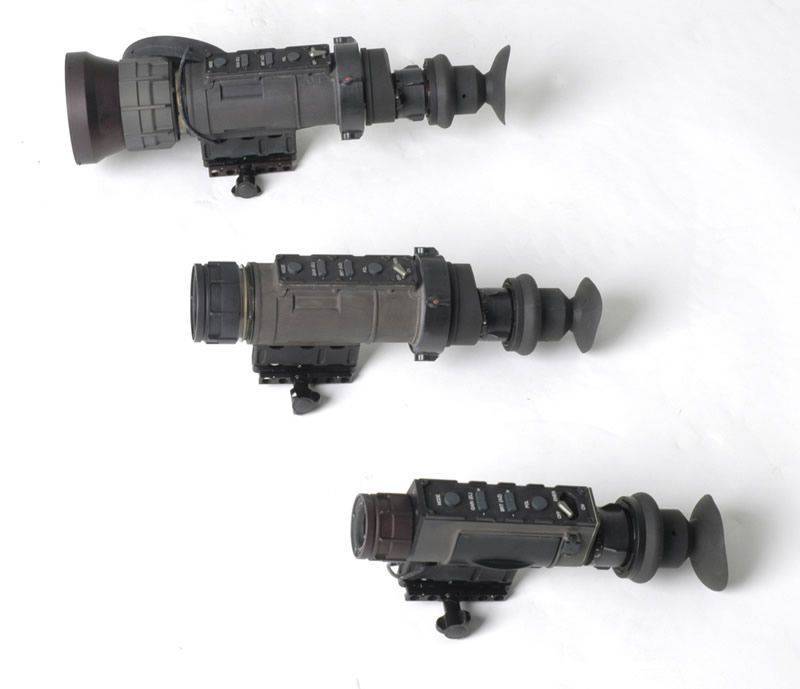
Sight family AN / PAS-13
Thermal sights
Among thermal imaging sights for small weapons The most massive is the AN / PAS-13 WTS device (Weapon Thermal Sight - weapon thermal sight), they were made over 33 000 pieces in three versions: light, medium and heavy. The WTS sight is in service with the American army since 1998, and all these years it has been consistently developed, retaining its designation. A light variant of this trinity, AN / PAS-13 LWTS, was originally based on an uncooled pixel sensor of 320x240 with a 25 micron step, operating at a wavelength of 8-12 micron. The development of matrix technology has led to improved versions, to the creation of a sensor of size 640x480 with a step of 17 micron.
The new LWTS has smaller dimensions (170x97x66 mm against 290x120x90 mm) and weight (816 grams with batteries and a guide against 907 grams of the previous version). The changes also affected the increase, which, due to the electronic increase in x2, was originally x1.55 in the wide field of view and x3.1 in the narrow field of view and the present time, respectively, x1 (14,2 °) and x2. The LWTS device guarantees the probability of finding a person on 1100 meters in clear weather 70% (decreases to 360 meters in bad weather, but at the same time the probability 90%). Four buttons at the top of the sight allow the soldier to work with him through the control menu and switch polarity from “white hot” (display mode of the thermal pattern with indication of hot objects in white and cold objects in black) to “black hot” and vice versa. There is a function of image capture in video mode (RS-170) for training, transferring images or remote viewing. On-time reduced from 20 to 5 seconds, powered by four AA L91 lithium batteries; previous models had 10 hours of battery life between battery replacements, while in subsequent models it was increased to 20 hours at 25 ° C (14 hours at -37 °). The LWTS AN / PAS-13 (V1) sight is designed for the M4 carbine, M16 assault rifle, M203 under-barrel grenade launcher and the installation of the M136 anti-tank missiles (Saab Dynamics AT-4). In 2015, it is planned to complete deliveries (on schedule in June) and achieve full operational readiness. As for the models MWTS and HWTS, then they have sensors 640x480 installed and they are intended mainly for weapons, serviced by calculations. Three manufacturers were selected to supply the AN / PAS-13 family of sights: BAE Systems, DRS Technologies and Raytheon.
Working for the future, the US Army recently launched a new program to develop a family of weapons sights, the Family of Weapon Sights (FWS), which will include sights for individual weapons, weapons serviced by calculations and sniper rifles. Scopes will be based on uncooled thermal sensors; a fixed thermal imaging sight will have a wireless communication channel that will allow the soldier to see in his improved night vision goggles AN / PSQ-20 ENVG (Enhanced Night Vision Goggle) III image with a sight and a reticle. This will allow the soldier to fire without being detected. The Rapid Target Acquisition feature will significantly reduce target acquisition times, according to the available data on 50%. The FWS-I (individual) will weigh less than 907 grams, have a field of view 18 °, the detection range of 960 meters and seven hours of operation with one battery change, although it has not yet been decided on how many AA batteries the new system will work. In May 2014, the army contract management announced that 800 million dollars had been allocated to BAE Systems Electronic Systems and DRS Technologies Imaging and Targeting Solutions (ITS) for the development of FWS-I and ENVG III systems. In the next five years, these two companies will compete for separate army contracts. Both companies will introduce ultra-wideband radio technology to connect sight and glasses through a high-speed, hard-to-determine communication channel from Alereon. The wireless channel will reduce the weight and allow you to get rid of the wire between the sight and the glasses, which often clings to the knots and branches.
NIVISYS
In the field of thermal sights, the American company Nivisys offers a different family of systems, each of which includes several models that differ in sensors and lenses. The Taws series of thermal sights (Thermal Acquisition Weapon Sight - thermal imaging weapon sights of target acquisition) can be equipped with three different vanadium oxide microbolometers from Flir Systems. These are 160x120 microbolometers with 25 micron increments, 320x240 with 25 microns increments or optionally with 17 microns increments and 640x480 with micron 17 steps, all have 7-14 microns in range. Accordingly, the larger the matrix and the smaller the pitch, the higher the cost of the sight.
At the lower end of the family is the Taws-16 scope, the number indicates the first two digits of the number of horizontal pixels of the matrix. It comes only with an 35 mm F / 1.4 lens, giving an increase in x2.3, a field of view 7 ° x5 ° and the detection range of a person and vehicle 695 and 1328 meters respectively. Thermal imagers of the Taws series can also be equipped with an LCD or color OLED display (display on organic light-emitting diodes), respectively, the letter “c” or “i” is added to the designation.
All Taws sights are equipped with 35 mm lenses (the letter M is added to the designation), 590 grams with batteries weigh, their dimensions are 152xXNNXX68 mm. The -68cM and -16iM models feature selectable crosshairs, digital wind and vertical correction adjustments, polarity control, display brightness and digital zoom control, as well as several different display modes. These include the warning mode (the white color changes to red), monochrome, and four different color modes, which allow you to optimize the presentation of the picture depending on the situation. There is a remote switch to adjust the sight, allowing you to save the position for shooting; as well as in the scope itself, the adjustment is made with one button. The sight is powered by two CR16 lithium batteries, which guarantee four hours of work. All these features are common to the entire Taws family, including an image capture system for storing photos and videos in internal memory, which can then be transferred to an SD card using an optional set.
The Taws-32 model has a sensor with 320x240 matrix and three different lenses, 35 mm F / 1.4 (M), 60 mm F / 1.25 (L) and 100 mm F / 1.4 (E), which when used with the matrix with 25 micron pitch provide respectively an increase in x1.8, x3.1 and x5.4. Compared to the aforementioned figures, the 60 mm lens mass increases to 724 grams and dimensions to 180x67x74 mm, the sight with the 100 mm lens weighs 1167 grams and has dimensions 249X86X86 mm. Here we will focus on trailers with a smaller increase, since they are more widely distributed among the troops. Taws-32cM and -32iM have a field of view of 13 ° x10 °, their identification ranges are 719 and 1368 meters depending on the target; physical characteristics are similar to those of the Taws-16 model. The 17 micron sensor version has a narrower field of view 9 ° x7 °, but, respectively, increased 883 and 1679 meters.
The most advanced system among 35-mm systems is the Taws-64 model with a larger matrix, it has an increase in x1.4 and a range of 719 and 1368 meters, but the field of view is 18 ° x13 ° and the best resolution.
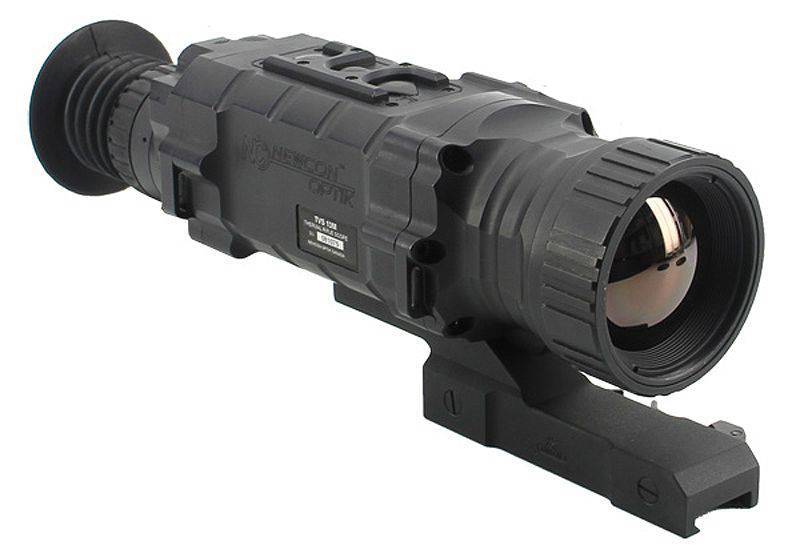
Newcon Optik's TVS-13M Thermal Sight can be fitted with various types of heat-sensitive arrays, allowing you to respond flexibly to market demands.
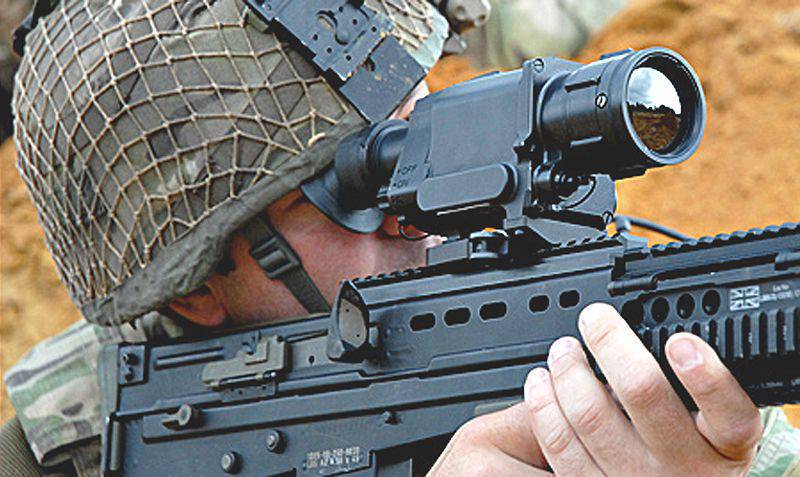
QioptiQ's Dragon SR model has an x3 optical zoom that can be doubled thanks to digital zoom.
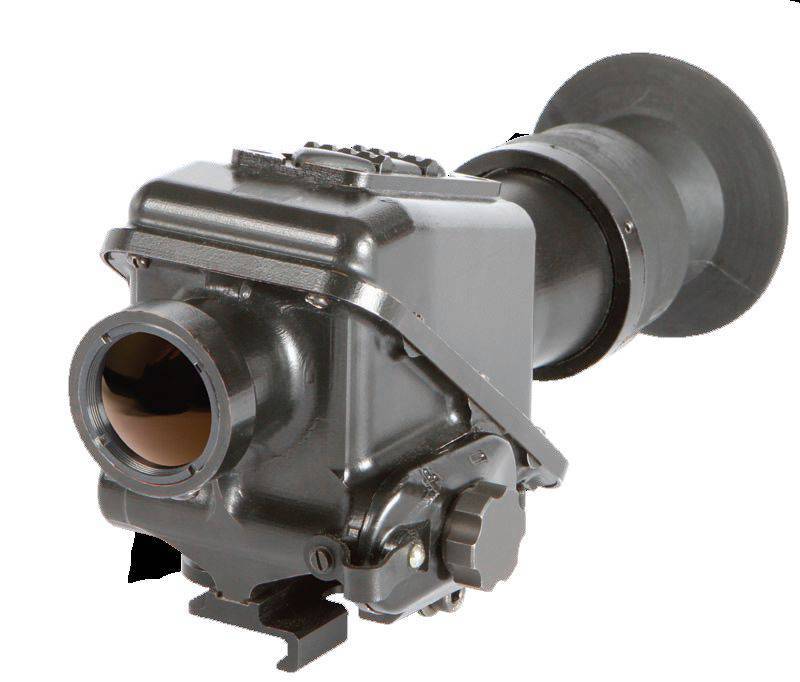
Sight QioptiQ Dragon Compact is in service with the German army
NEWCON-OPTIK
The Newcon-Optik company in the field of thermal imaging sights offers a TVS 13M device, which can be equipped with two different types of uncooled microbolometers operating in the 7-14 micron range: 384x288 pixels in 25 microns or 640XXNNXX pixels in 480 microns; accordingly, the prices of these sights are significantly different. A lens with a focal length 17 mm provides an increase of x54 and, depending on the matrix, gives the field of view 2 ° x10 ° or 8 ° x12 °; There is an electronic increase in x9 and x2, and an increase in x4 is optional. The detection, recognition and identification ranges of a person are respectively 8, 1800 and 450 meters. Eight pre-programmed crosshairs and four ballistic profiles are built into the TVS 225M scope, which allows you to quickly adapt it to a specific weapon. Automatic inversion of the color of the crosshair ensures maximum visibility of the reticle depending on the polarity or the selected color, the sight allows you to set sepia, rainbow or other options. Each device can store in memory three preset zero settings, which allows you to quickly rebuild the zero assembly line of weapon-sights with several confirmation shots in the case when the sight was mounted on another rifle and now returns to the original weapon. A large number of crosshair configurations can be developed and the Canadian company is ready to provide them to customers for installation in sights already in service; All work is done programmatically (firmware). PAL or NTSC video output is also available. The sight is powered by six AA batteries, which provide eight hours of work; weight without batteries is 13 grams, dimensions 950x280x68 mm. The TVS 78M target, released in 13, achieved significant success in the overseas market.
QIOPTIQ
The QioptiQ portfolio of thermal imaging sights for small arms includes the Dragon family, which includes Compact and Short Range models for infantrymen. Systems with a large radius of action are more likely intended for machine gunners and snipers.
The lightest member of the Dragon-C family weighs less than 390 grams without batteries and fasteners, has a total length of 135 mm, a height of 83 mm and a width of 70 mm. An uncooled microbolometer array of size 320x240 has a step of 25 microns; The system operates in the 8-12 micron range. The sight with x1 magnification has a horizontal field of view 16 ° and allows you to identify a person with 910 meters or with 1070 meters with electronic zoom x2. Its aluminum housing not only guarantees “protection against careless or improper handling”, but also improves its electromagnetic compatibility. The sight works on two lithium AA batteries on 1,5 volts, which provide over 5 hours of uninterrupted operation, however, an external power source can be connected. The push buttons located at the top of the sight allow you to control the polarity, magnification, brightness and perform system setup; There is an RS232 connector that allows you to record and transfer images to other displays or recorders. Dragon-C, as a matter of fact, being a sight, has several sight lines that can be selected through the system menu, however, they can be turned off and then this thermal imaging system can be used either as a manual surveillance system or as a fixed device that is installed in front riflescopes with magnification up to x4. Because of its compactness and low mass, Dragon-C was chosen by Germany as a standard short-range thermal sight for use in combination with the Zeiss Optics 4x30 day sight for the Infanterist der Zukunft - Erweiterte System (IdZ-ES) program.
The Dragon-SR model has the same sensor as the Dragon-C, but it is much heavier with 730 grams without batteries and mounting and larger (length 245 mm, height 121 mm and width 94 mm), but its optics provide an increase of x3 and field of view 8 °. Plus there is also an electronic zoom x2. The human detection range is 2,3 km in standard mode and differs slightly when using electronic zoom. Four AA lithium batteries are installed on the left side of the sight and guarantee over eight hours of continuous operation at 23 ° C. An optional holographic sight can be mounted to conduct close combat over a thermal imager. For the British Fist program (Future Integrated Soldier Technology - a promising integrated technology for the soldier), the Dragon-SR scope was updated to the FTS2 configuration, while the original British soldiers received the FTS1 instrument, which originated from the outdated Vipir scope.
PYSER SGI
The British company Pyser SGI states that it has developed the smallest and lightest thermal imaging weapon PNP-MTHDS, designed for small arms caliber up to 7,62xXNNUMX mm. The sight is ready for delivery from the end of the 51 year; It is available with three different lenses with a focal length 2013, 17 and 25 mm and a corresponding x35, x1 and x1.5 magnification and 2 ° x36 °, 29 ° x25 ° and 19 ° x18 ° field of view. The image is formed by an uncooled high-resolution microbolometer with a size of 14.5x640 pixels on amorphous silicon with a step of 480 micron and a refresh rate of 17 Hz. The image is displayed on a monochrome SVGA-display with a size of 25x852 pixels, which represents the apparent 600 ° field of view in the horizontal plane, which eliminates the tunnel effect; if necessary, the electronic zoom modes x35 and x2 are available. There are five cross hairs plus a no crosshair mode for observation, a wind offset and a vertical angle depending on the lens - one mil per click for a shorter lens and 4 and 0,7 mil per click for other lenses.
Pyser’s MTHD universal monocular is largely based on the MTHDS thermal sight, from which it took most of its optical performance.
PNP-MTHD (pictured as a manual device) manufactured by Psyer-SGI in a lightweight configuration weighs less than 300 grams without batteries
The soldier can choose the polarity and set the brightness of the screen due to the push buttons on the right side of the device, where two CR123A lithium batteries are installed, which provide seven hours of operation. The weight and length depends on the optics, the 17-mm version weighs 347 mm without batteries, has a length of 96 mm, a height of 74 mm and a width of 77 mm; weight rises to 377 grams and 392 grams with lenses of greater length, and length increases to 110 mm and 122 mm. The short lens version ensures that the person is detected on 625 meters, recognized on 315 meters and identified on 160 meters without using digital zoom; these numbers increase linearly due to the increase in longer lenses.
PNP-MTHDS has a PAL video output; The MTHDES version with integrated digital video recording on 155 is heavier and higher on 19 mm. It has a memory of 32 gigabytes, which allows you to record from 40 to 120 hours of video recording, depending on the resolution. The sight can dive for one meter for half an hour. There is no information about the customers of this sight, although the company emphasizes that the PNP-MTHDS is free from restrictions on the rules of the arms trade.
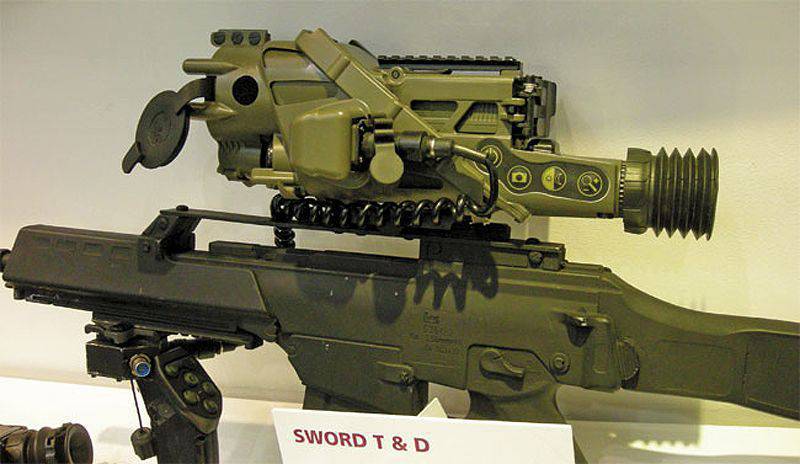
Sage T / D thermal imaging from Sagem for the Felin French Army program. A variant with enhanced image brightness is also offered by this company.
SAGEM
Sagem has also developed a night / daytime thermal imager under the Sword T / D designation, which is very similar to the already mentioned daytime image enhancement sight included in the Felin program. It is very similar in parameters to the previous model, but the brightness enhancement tube is replaced by a thermal imager, under which the day channel is located. The latter is based on an uncooled microbolometer matrix of 384x288 pixels, which provides a wide 9.4 ° field of view, shrinking to 4.7 ° with electronic zoom. This allows you to get the detection range of a person / machine 2 / 3,4 km and the recognition range 700 / 1200 meters. The power source and the mass of this sight (1,5 kg) remained the same as in the version with enhanced image brightness. As for the brightness amplifier, it is also proposed as a basis, with the exception of the French for other modernization programs.
With devices for the Felin program on its track record, Sagem seeks to enter the export market and therefore has developed a lighter and cheaper system (albeit only a thermal imaging system) to meet the needs of those countries that do not need an integrated day / night sight. As a result, the Sword Light sight appeared, in which there is the same sensor as in Sword T / D. It is available in two versions: Sword Light-25 and Sword Light-35, where the numbers indicate the focal length in millimeters (both have a digital zoom x2 and x3). Sword Light-25 has an x1.1 magnification and provides an 22 ° field of view, an x3 magnification narrows it to 7.3 °; The 35 model mm has an x1.6 magnification and a 15.7 ° field of view and shrinks to 3 ° with an increase in x5.2. Obviously, the difference in focal length changes the recognition and identification detection distances, which for the Sword Light-25 sight are 930 / 310 / 160 meters for humans and 1600 / 550 / 280 meters for the machine, for the 35-mm version these numbers increase to 1200 / 400 / 200 and 2070 / 720 / 370 meters. Analog video output allows you to export video in PAL format. Digital ports MP4 and USB 2.0 are optional, because there is an internal memory on 4 or 8 gigabytes. Sword Light is powered by four AA batteries, which guarantee eight hours of use in standard conditions. The Sagem thermal sight weighs 730 grams with a 25 mm lens, and an 35 grams is added to the 20-mm lens.
Sword Light has a high level of unification with Tips (Thermal Imager Pocket Scope - a pocket thermal imaging device for observation), which, compared with the sight, has the same output connectors and memory size (up to 1000 photos or three hours of video) as a standard option; its weight at the same time increased slightly by 100 grams.
A French soldier armed with a Famas rifle with a Sword TD mounted day / night sight. Adapted versions of these sights are offered by Sagem for other soldier modernization programs.
WILCO
Wilco WS937 thermal sight is available with two levels of resolution: standard 384x288 pixels in 25 micron increments and high with 640x480 sensors in 17 micron increments. Lenses with x2, x3 and x4 magnifications can be installed in the device. The x2 magnification option comes with an F / 50 1.0-mm lens providing a 12 ° x9 ° field of view. Digital zoom allows you to get a total increase of x4 and x8. The mass is 700 grams and dimensions are 210x90x65 mm, and two AA lithium batteries guarantee eight hours of operation. The image is displayed on an oled display with a pixel size of 800x600, polarity inversion is also available as standard, as well as video output. A USB2 port with image recording and editing software, lithium-ion batteries and wireless video transmission are available on request.
SELEX
Another development, aimed at the Italian program Soldato Futuro and dubbed Aspis, is in fact more than just a night sight, because it has day and night capabilities and a Bluetooth communication channel to connect to the soldier system. The device is based on an uncooled 320x240 sensor operating in the 8-12 micron range, has an x1 magnification and provides an 17.9 ° x13.5 ° field of view. The color camera also has an x1 magnification and a field of view 8.8 ° x6.6 °; Images are displayed on a color display with a pixel size of 800x600. The Aspis sight has a length of 293 mm, a width of 71 mm and a height of 133 mm; It weighs 1166 grams, including AA batteries. A small number of these systems were manufactured, mainly for testing.
The army considered it too heavy and cumbersome and went from a fully integrated system to an intermediate modular device. As a result, Selex began the development of a thermal imaging sight based on an uncooled microbolometric array of 640x480 pixels with a 17 micron pitch. The device with an optical zoom x1 has a digital zoom x4, it can be mounted on a weapon or used as a handheld device; it is powered by two CR123 batteries, which guarantee autonomy for more than four hours under standard conditions.
Currently, the device received the designation Mini Sight AC 640, images from it are displayed on an oled display (screen on organic light-emitting diodes) with a resolution of 800x600 with proximity sensors, which allow you to turn off the screen when a soldier does not look at it, which makes the device less noticeable. The device weighs 350 grams, it has a built-in image recording function and a bluetooth wireless channel for transmitting images to other displays or to higher-level control points. Selex ES manufactured the first samples at the end of 2014 of the year and plans to ship them to the Italian army for testing in 2015.
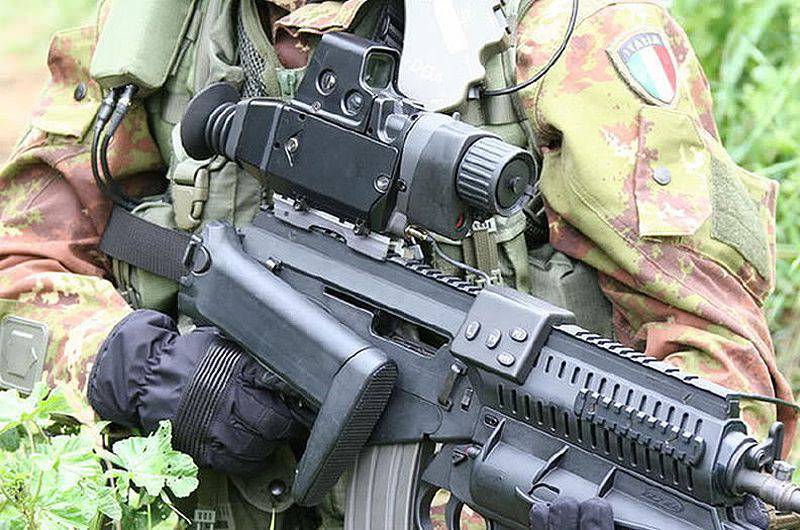
The original requirement of the Italian program Soldato Futuro provides for the installation of a sight with day and night channels, fully integrated into the system of the future soldier. As a result, the company Selex Galileo has developed a system designated Aspis
Tested in battles in Afghanistan by the Polish armed forces, the SCT Rubin thermal sight kit also includes a helmet-mounted display for conducting surveillance / shooting from around the corner.
PCO
In the portfolio of the Polish company PCO, the SCT Rubin thermal sight is designed for an infantryman. The first shipments to the Polish army took place in 2013, the scope was sent to Afghanistan to increase the capabilities of the soldiers at night. The device is based on an uncooled microbolometric matrix of 288x384 pixels, operating in the 8-12 micron range. The sight has an x1 magnification and a 7.5 ° x5.5 ° field of view, as well as an x2 electronic magnification (the person identification distance is 1,2 km).
The image is displayed on the display in the size of 800x600 pixels, the sight has a PAL 768x576 video output and an RS 485 data transmission connector. Rubin can be equipped with a helmet-mounted display that provides the soldier with observation and firing capabilities around the corner, and can also be used to display other data (the display is powered by the sight and therefore weighs less than 300 grams). The sight itself has a length of 300 mm, a width of 85 mm and a height of 110 mm, weighs less than 1,3 kg with six batteries. It can either be Ni-Cd AA batteries on 1,2 volts or standard AA disposable batteries that provide 12 hours of continuous operation. A slightly smaller modification of the SCT Rubin sight, working on new software, was taken by the Polish army for its modernization program for the soldier Tytan.
THERMAL VISION TECHNOLOGIES
The Ukrainian company Thermal Vision Technologies has an extensive catalog of thermal imaging imaging systems and all are based on Flir sensors. The Kiev company offers its products in various versions in order to meet the needs of customers with different wallet sizes. The Archer TSA-9 model is the successor of the TSA-5 sight, it is available with different optics. The lighter version of the TSA-9 / 55 is equipped with a lens with a focal length 55 mm and aperture 1.0, its weight with batteries is 950 grams. The field of view depends on the sensor: 6.0 ° x4.8 ° when installing an uncooled 336x256 microbolometer on vanadium oxide or it increases to 11 ° x9.0 ° with a matrix of 640x512 pixels. In both cases, the sensors have an 17 micron pitch and operate in the 7,5-13,5 micron range. The TSA-9 series sights all have x1 magnification, x2 and x4 digital magnification, and, in addition, several color palettes to enhance the image quality, which is displayed on a color oled display with the size of 800X600. The sight allows you to detect a target the size of a person at a distance of 1700 meters, recognize 400 meters and identify 200 meters. The memory contains up to 20 different target lines with the ability to edit and load new ones (for example, a crosshair with a crosshair with automatic contrast inversion in order to optimize its color against the landscape). The built-in recording module allows you to save photos and videos in PAL or NTSC standards, which are then transmitted either via cable via USB port or wirelessly via WiFi. The Archer TSA-9 / 55 sight has a length of 270 mm, a width of 68 mm and a height of 78 mm, its body is waterproof in accordance with IP67 standards. It is powered by six AA batteries, which are equipped with one unit for quick replacement; they guarantee a continuous operating time for 8-10 hours under standard conditions.
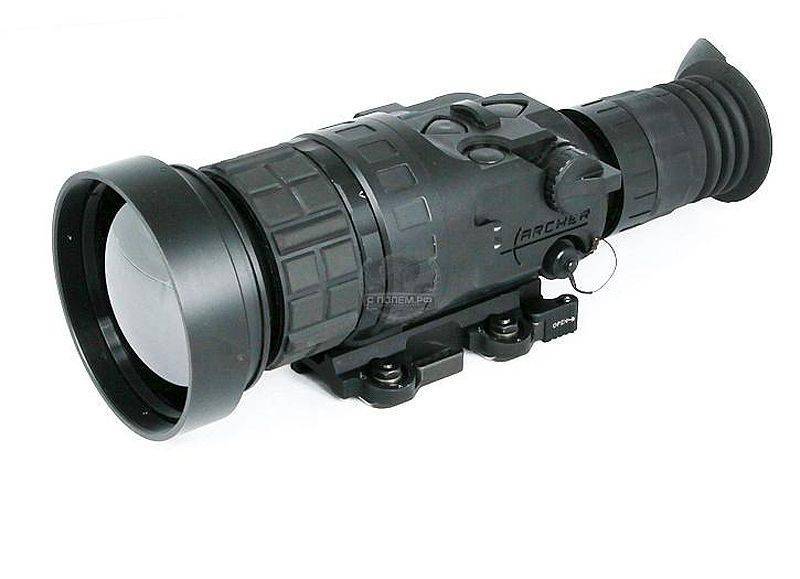
Ukrainian sight Archer TSA-9 / 75
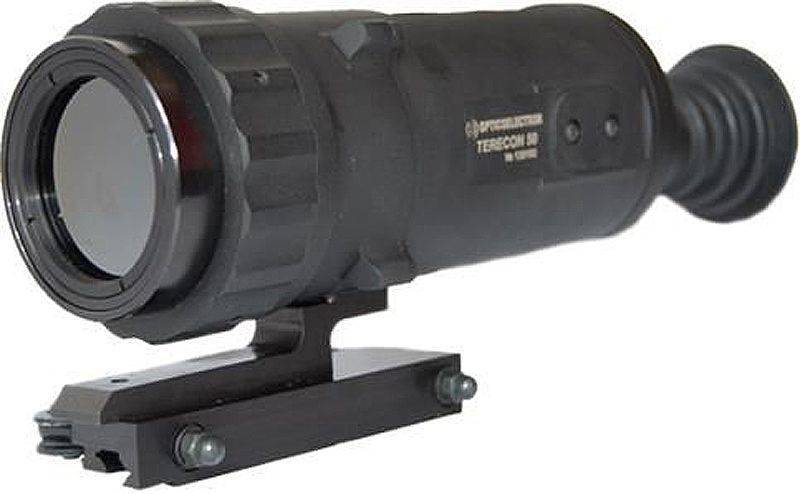
Among the latest products of the Bulgarian company Opticoelectron we can see the Terecon TS 50 thermal imager, based on an uncooled sensor with a size of 336xXNNXX pixels
OPTICOELECTRON
The Bulgarian company Opticoelectron has developed a Terecon TS 50 thermal imaging system designed for mounting on weapons, ranging from assault rifles to large-caliber machine guns. The device is based on an uncooled microbolometer on vanadium oxide of 336x256 size and 17 micron pitch, operating in the 7,5-13,5 micron range. In combination with the 50 mm F / 1.2 lens, the sight with x1 magnification gives the 6.5 ° x5 ° field of view, and the x2 digital zoom is also available. The image is displayed on a color SVGA display with a pixel size of 800x600; image processing includes optimization and digital underlining of details; the operator can switch the polarity, turn on the “black-hot” mode (display mode of the thermal pattern with indication of hot objects in black and cool objects in white) or “white-hot” (on the contrary, hot objects in white and cold objects in black), and choose a color or monochrome palette. According to the company Opticoelectron, the detection, recognition and identification ranges are 1500 / 380 / 190 meters for a person with dimensions 1,8x0,5 meters and 3900 / 1060 / 540 meters for a vehicle sizes 2,3x2,3 meters. The Terecon TS 50 sight weighs 860 grams without four AA batteries, which guarantee six hours of continuous operation.
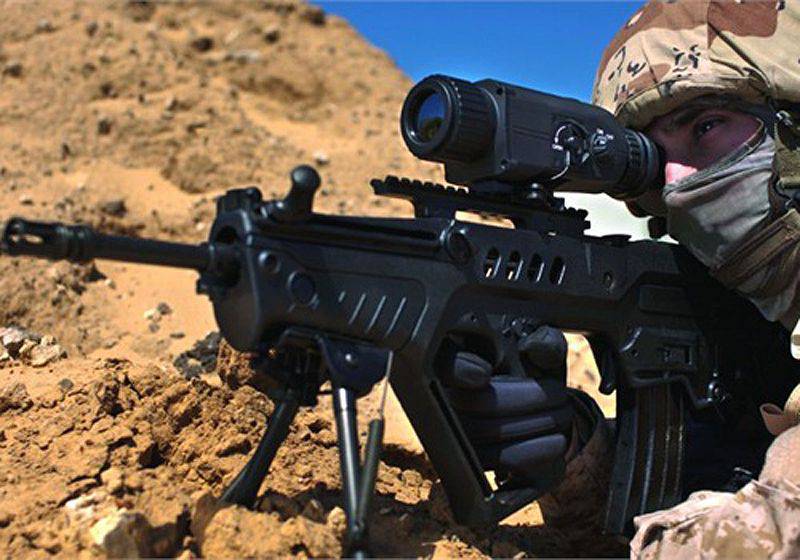
A smaller member of the Noa Nyx family in the Meprolight catalog of the Nyx 2 thermal sight is offered for an ordinary soldier, its weight is less than one kilogram
MEPROLIGHT
The Israeli company Meprolight offers for a typical infantryman the thermal sight Noa Nyx 2x, a smaller product from the Noa Nyx family. It has an uncooled microbolometer measuring 384x288 and 25 micron increments, operating in the 8-12 micron range. Noa Nyx 2x and Noa Nyx 3x sights have different optics, the smaller one has an x1.6 magnification and a 15.6 ° x11.7 ° field of view. Digital magnification x2 or x4 is available, the image is displayed on the OLED display SuperVGA 768x576 with the removal of the pupil 45 mm. Meprolight announces the maximum range of 900 meters at which the Noa Nyx 2x can detect human activity. CCIR video output is available for recording images or transferring them to an auxiliary display, for example head-on. Standard power is provided from four AA batteries, either lithium or disposable, but external power sources from 9 to 31 volts can also be used. Lithium batteries provide up to seven hours of operation at 20 ° C. Without batteries, the Noa Nyx 2x weighs less than a kilogram, the length is 258 mm, the width 76 mm and the height 98 mm.
If the 2x model is better suited for the average soldier, then the Noa Nyx 3x option is for special tasks. It has a 384x288 matrix in 25 micron increments, operating in the 8-12 micron range. The sight has an increase in x2.7, which can improve aiming at medium distances, but a reduced field of view 9.14 ° x6.86 °. The length is increased to 275 mm, and the weight to 1,2 kg without batteries.
The Noa Nyx 3x from Meprolight, mounted on an IWI Tavor rifle. Since both companies belong to the same group, weapons and sight designs were coordinated.
Materials used:
en.wikipedia.org
www.newcon-optik.com
www.photonis.com
www.pyser-sgi.com
www.meopta.cz
www.pcosa.com.pl
www.shvabe.com
www.sagem.com
www.flir.com
www.qioptiq.com
www.airbusdefenceandspace.com
www.wilco-international.com
www.meprolight.com
www.opticoel.com
www.tvt-thermal.com
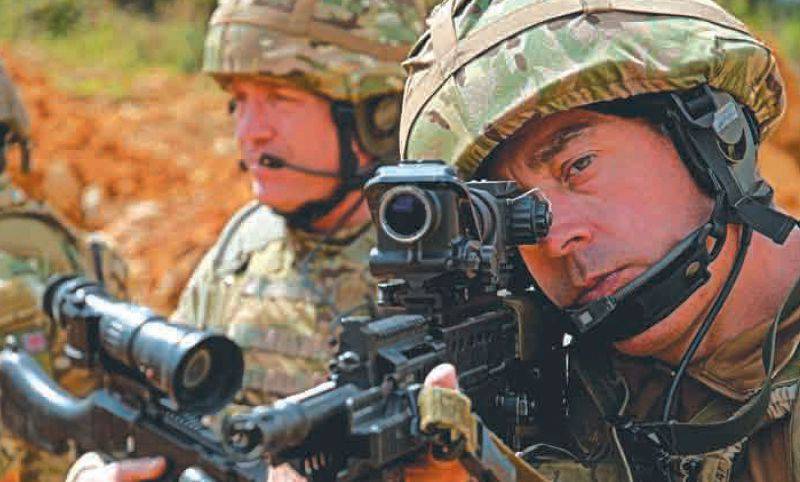
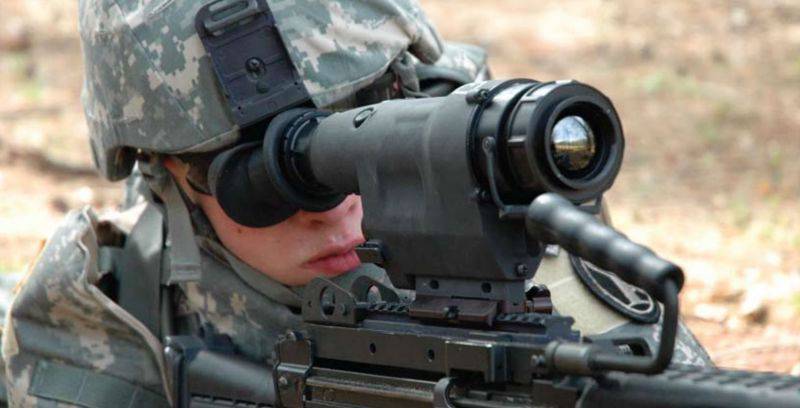
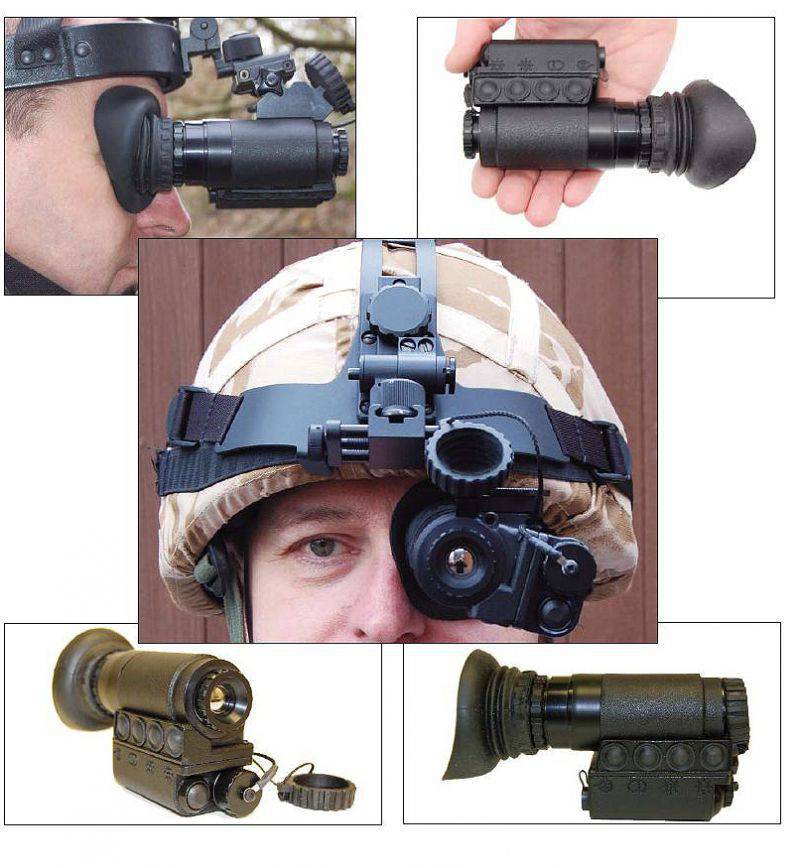
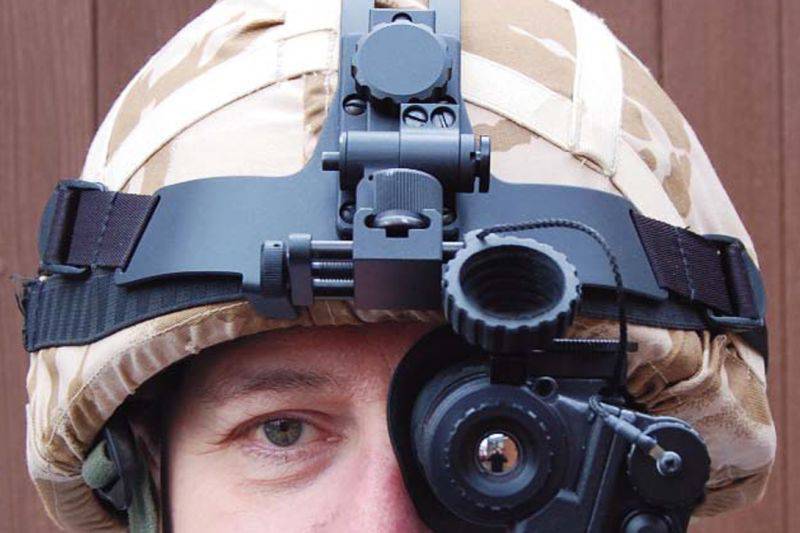
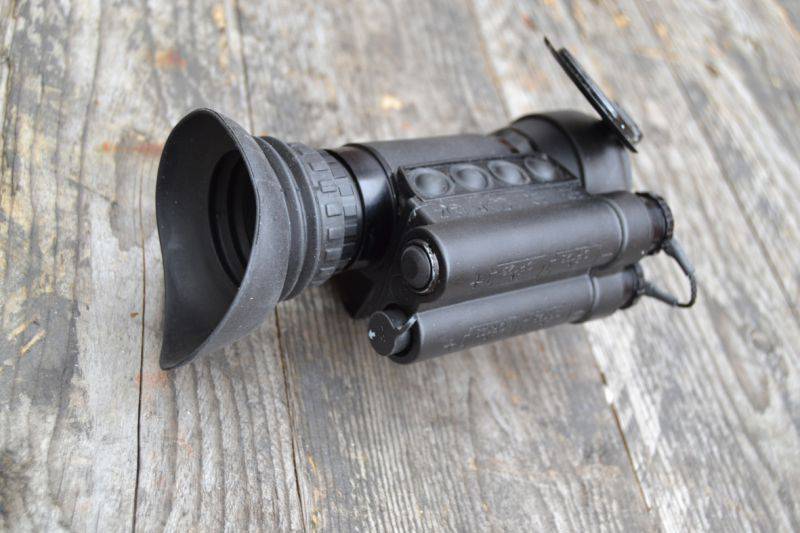
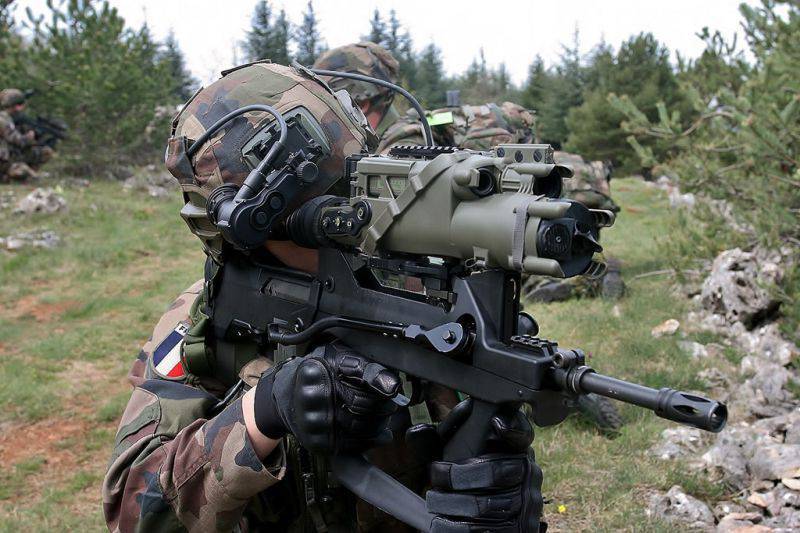
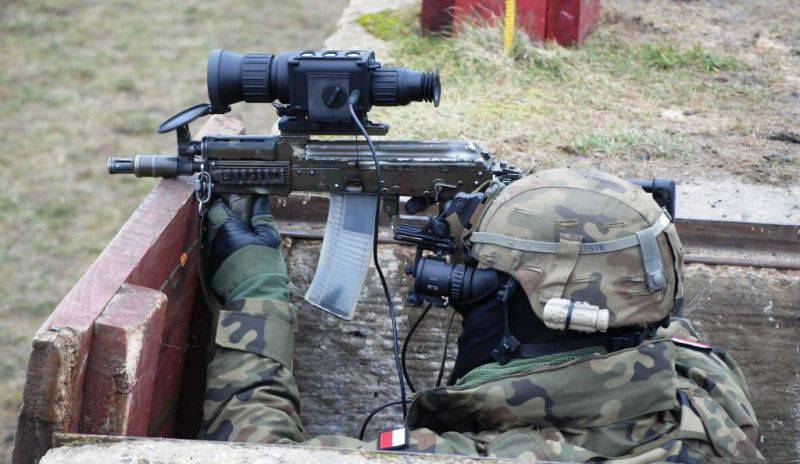
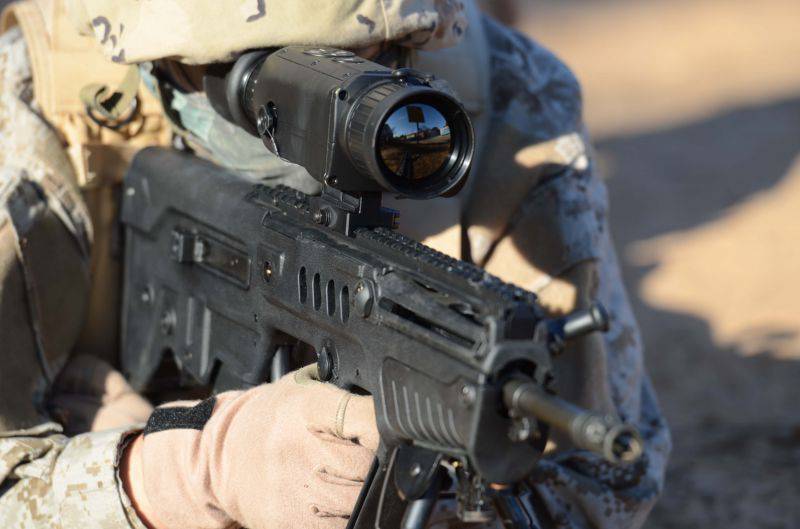
Information